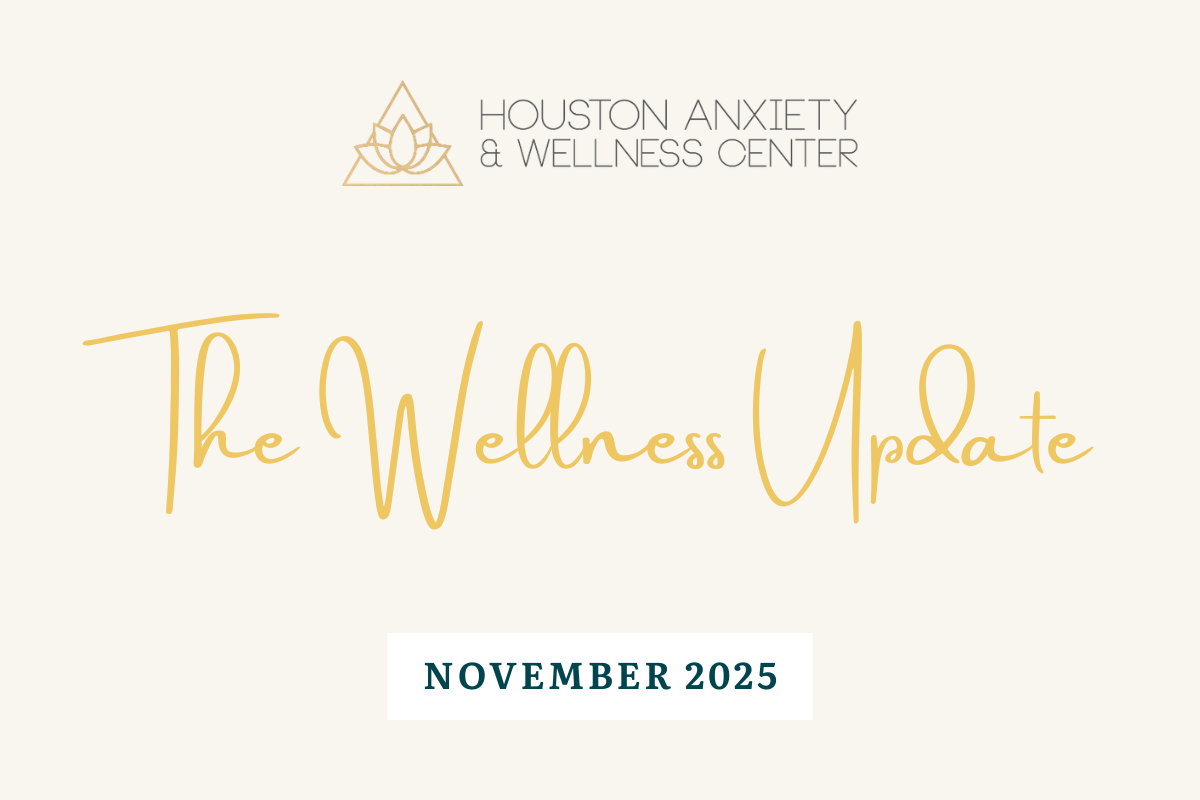How to Protect Your Peace This Holiday Season
Feeling the holiday chaos creeping in? This month’s update brings easy, gentle ways to slow down, set boundaries, and enjoy what really matters.
.avif)
If you’ve ever found yourself absentmindedly biting your nails, twirling your hair, or picking at skin imperfections in the mirror, you’re just like the rest of us. Most people engage in some kind of grooming behavior, but for some, these behaviors are more than a habit. Nail or lip biting, hair twirling and pulling, skin picking, and cheek biting are often seen as harmless habits, but they can turn into compulsive, distressing behaviors known as Body-Focused Repetitive Behaviors (BFRBs). BFRBs can significantly impact emotional well-being, self-esteem, and physical health.
At Houston Anxiety and Wellness Center we work with many individuals of all ages struggling with BFRBs. Often these behaviors are clouted in secrecy and shame. We help our clients explore and overcome the reasons they engage in these often self soothing behaviors. Treating BFRBs requires specific knowledge, unconditional compassion, and specialized training in the right treatment.
BFRBs are compulsive grooming behaviors that cause both physical and emotional damage. These behaviors can be difficult to control, and often leading to embarrassing and painful consequences like bleeding nail beds, scabs that won’t heal, and bald spots. Some of the most common types of BFRBs include:
These behaviors might seem like simple habits, however they are actually complex, ingrained patterns that can be difficult to stop without proper intervention.
BFRBs fall under Obsessive-Compulsive and Related Disorders in the DSM-5 (Diagnostic and Statistical Manual of Mental Disorders). However, they are distinct from OCD. Unlike OCD, which is driven by intrusive thoughts and compulsions performed to reduce anxiety, BFRBs are often triggered by sensory experiences or emotional states. These behaviors can be conscious or unconscious.
A diagnosis of a BFRB generally includes the following criteria:
Many individuals with BFRBs report engaging in these behaviors more frequently during times of stress, boredom, or intense concentration.
Several treatment approaches have been found to be effective in reducing these behaviors.
CBT, specifically Habit Reversal Training (HRT), is one of the most widely used treatments. This involves:
ACT helps individuals accept distressing emotions rather than trying to suppress them. Mindfulness techniques and values-based decision-making are key components in reducing engagement in BFRBs.
There is no FDA-approved medication specifically for BFRBs, but some individuals find that SSRIs (commonly used for anxiety and OCD) or N-acetylcysteine (NAC), a supplement that influences glutamate regulation in the brain, can help reduce urges.
This model addresses five core factors contributing to BFRBs:
Treatment is then tailored and individualized to the specific factors influencing a person’s unique engagement in the BFRB.
If you or a loved one struggles with a BFRB, there are effective steps you can take to help manage it.
Tracking behaviors in a BFRB journal can help identify patterns. Recording when, where, and why the behavior occurs increases self-awareness and provides insight into triggers.
Since stress is a common trigger, prioritizing stress management is crucial. Effective strategies include:
Connecting with others who experience BFRBs can reduce feelings of isolation. Online support groups and therapy communities can provide encouragement and shared strategies.
Managing a BFRB is a process, and setbacks are normal. Instead of self-criticism, practice self-kindness and recognize progress, no matter how small.
BFRBS are more than just habits—they are complex conditions that require understanding and structured intervention. If you or someone you care about is struggling, know that help is available, and change is possible. Through increased awareness, targeted behavioral strategies, and professional support, individuals with BFRBs can regain control and improve their quality of life.
If this post was helpful, consider sharing it with someone who might benefit. And if you’re struggling with a BFRB, reach out to us or another trained mental health professional. We can expertly guide you, while collaborating and individualizing your BFRB treatment plan so we are truly getting to the root of the problem.
Privacy Notice: By providing your email, you understand this resource is educational only and doesn't establish a therapeutic relationship. We use Flodesk (non-HIPAA compliant) to deliver this content and general practice updates. Your email will not be shared with third parties.
If you’ve ever found yourself absentmindedly biting your nails, twirling your hair, or picking at skin imperfections in the mirror, you’re just like the rest of us. Most people engage in some kind of grooming behavior, but for some, these behaviors are more than a habit. Nail or lip biting, hair twirling and pulling, skin picking, and cheek biting are often seen as harmless habits, but they can turn into compulsive, distressing behaviors known as Body-Focused Repetitive Behaviors (BFRBs). BFRBs can significantly impact emotional well-being, self-esteem, and physical health.
At Houston Anxiety and Wellness Center we work with many individuals of all ages struggling with BFRBs. Often these behaviors are clouted in secrecy and shame. We help our clients explore and overcome the reasons they engage in these often self soothing behaviors. Treating BFRBs requires specific knowledge, unconditional compassion, and specialized training in the right treatment.
BFRBs are compulsive grooming behaviors that cause both physical and emotional damage. These behaviors can be difficult to control, and often leading to embarrassing and painful consequences like bleeding nail beds, scabs that won’t heal, and bald spots. Some of the most common types of BFRBs include:
These behaviors might seem like simple habits, however they are actually complex, ingrained patterns that can be difficult to stop without proper intervention.
BFRBs fall under Obsessive-Compulsive and Related Disorders in the DSM-5 (Diagnostic and Statistical Manual of Mental Disorders). However, they are distinct from OCD. Unlike OCD, which is driven by intrusive thoughts and compulsions performed to reduce anxiety, BFRBs are often triggered by sensory experiences or emotional states. These behaviors can be conscious or unconscious.
A diagnosis of a BFRB generally includes the following criteria:
Many individuals with BFRBs report engaging in these behaviors more frequently during times of stress, boredom, or intense concentration.
Several treatment approaches have been found to be effective in reducing these behaviors.
CBT, specifically Habit Reversal Training (HRT), is one of the most widely used treatments. This involves:
ACT helps individuals accept distressing emotions rather than trying to suppress them. Mindfulness techniques and values-based decision-making are key components in reducing engagement in BFRBs.
There is no FDA-approved medication specifically for BFRBs, but some individuals find that SSRIs (commonly used for anxiety and OCD) or N-acetylcysteine (NAC), a supplement that influences glutamate regulation in the brain, can help reduce urges.
This model addresses five core factors contributing to BFRBs:
Treatment is then tailored and individualized to the specific factors influencing a person’s unique engagement in the BFRB.
If you or a loved one struggles with a BFRB, there are effective steps you can take to help manage it.
Tracking behaviors in a BFRB journal can help identify patterns. Recording when, where, and why the behavior occurs increases self-awareness and provides insight into triggers.
Since stress is a common trigger, prioritizing stress management is crucial. Effective strategies include:
Connecting with others who experience BFRBs can reduce feelings of isolation. Online support groups and therapy communities can provide encouragement and shared strategies.
Managing a BFRB is a process, and setbacks are normal. Instead of self-criticism, practice self-kindness and recognize progress, no matter how small.
BFRBS are more than just habits—they are complex conditions that require understanding and structured intervention. If you or someone you care about is struggling, know that help is available, and change is possible. Through increased awareness, targeted behavioral strategies, and professional support, individuals with BFRBs can regain control and improve their quality of life.
If this post was helpful, consider sharing it with someone who might benefit. And if you’re struggling with a BFRB, reach out to us or another trained mental health professional. We can expertly guide you, while collaborating and individualizing your BFRB treatment plan so we are truly getting to the root of the problem.

Feeling the holiday chaos creeping in? This month’s update brings easy, gentle ways to slow down, set boundaries, and enjoy what really matters.

When anxiety starts to bubble up, especially during the holidays, learn how to cool it down with mindfulness, movement, and self-compassion.